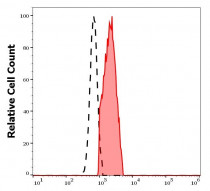ARG65433
anti-CD84 antibody [CD84.1.21] (FITC)
anti-CD84 antibody [CD84.1.21] (FITC) for Flow cytometry and Human
Developmental Biology antibody; Immune System antibody
Overview
| Product Description | FITC-conjugated Mouse Monoclonal antibody [CD84.1.21] recognizes CD84 |
|---|---|
| Tested Reactivity | Hu |
| Tested Application | FACS |
| Specificity | The clone CD84.1.21 recognizes CD84, a single chain cell surface glycoprotein of 64-82 kDa, predominantly expressed B cells, monocytes, platelets and some T cells. |
| Host | Mouse |
| Clonality | Monoclonal |
| Clone | CD84.1.21 |
| Isotype | IgG2a |
| Target Name | CD84 |
| Immunogen | CD84-transfected 300.19 cell line |
| Conjugation | FITC |
| Alternate Names | hCD84; Leukocyte differentiation antigen CD84; Hly9-beta; CD antigen CD84; LY9B; mCD84; Cell surface antigen MAX.3; SLAM family member 5; SLAMF5; Signaling lymphocytic activation molecule 5 |
Application Instructions
| Application Suggestion |
|
||||
|---|---|---|---|---|---|
| Application Note | * The dilutions indicate recommended starting dilutions and the optimal dilutions or concentrations should be determined by the scientist. |
Properties
| Form | Liquid |
|---|---|
| Purification Note | The purified antibody is conjugated with Fluorescein isothiocyanate (FITC) under optimum conditions. The reagent is free of unconjugated FITC and adjusted for direct use. No reconstitution is necessary. |
| Buffer | PBS, 15 mM Sodium azide and 0.2% (w/v) high-grade protease free BSA |
| Preservative | 15 mM Sodium azide |
| Stabilizer | 0.2% (w/v) high-grade protease free BSA |
| Storage Instruction | Aliquot and store in the dark at 2-8°C. Keep protected from prolonged exposure to light. Avoid repeated freeze/thaw cycles. Suggest spin the vial prior to opening. The antibody solution should be gently mixed before use. |
| Note | For laboratory research only, not for drug, diagnostic or other use. |
Bioinformation
| Database Links | |
|---|---|
| Gene Symbol | CD84 |
| Gene Full Name | CD84 molecule |
| Background | CD84 is a highly glycosylated homophilic receptor of SLAM family. It is expressed on platelets and various types of leukocytes, especially following their activation. Ligation of CD84 leads to its phosphorylation on tyrosine residues within the cytoplasmic tail. These docking sites are recognized by downstream signaling molecules, such as phosphatase SHP-2 and adaptor protein SAP/SH2D1A. The function of CD84 has not been fully elucidated yet. Although predominantly activating receptor, its modulating activity was also demonstrated. |
| Function | Plays a role as adhesion receptor functioning by homophilic interactions and by clustering. Recruits SH2 domain-containing proteins SH2D1A/SAP. Increases proliferative responses of activated T-cells and SH2D1A/SAP does not seen be required for this process. Homophilic interactions enhance interferon gamma/IFNG secretion in lymphocytes and induce platelet stimulation via a SH2D1A/SAP-dependent pathway. May serve as a marker for hematopoietic progenitor cells. [UniProt] |
| Research Area | Developmental Biology antibody; Immune System antibody |
| Calculated MW | 39 kDa |
| PTM | Phosphorylated by tyrosine-protein kinase LCK on tyrosine residues following ligation induced by agonist monoclonal antibody. The association with SH2D1A is dependent of tyrosine phosphorylation of its cytoplasmic domain. Phosphorylated on Tyr-296 and Tyr-316 following platelet aggregation. Phosphorylated on tyrosine residues upon high affinity immunoglobulin epsilon receptor aggregation in mast cells. N-glycosylated. |
Images (2) Click the Picture to Zoom In
-
ARG65433 anti-CD84 antibody [CD84.1.21] (FITC) FACS image
Flow Cytometry: Human peripheral whole blood stained with ARG65433 anti-CD84 antibody [CD84.1.21] (FITC) (4 µl reagent / 100 µl of peripheral whole blood).
-
ARG65433 anti-CD84 antibody [CD84.1.21] (FITC) FACS image
Flow Cytometry: Separation of human CD177 positive lymphocytes (red-filled) from neutrophil granulocytes (black-dashed). Human peripheral whole blood stained with ARG65433 anti-CD84 antibody [CD84.1.21] (FITC) (4 µl reagent / 100 µl of peripheral whole blood).
Clone References









